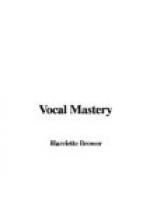“Singing pianissimo in the beginning is another fallacy. This is one of the most difficult accomplishments and should be reserved for a later period of development.
“The young singer adds to scales various intervals, sung twice in a breath, beginning, not at the extreme of the lower voice, but carried up as high as he can comfortably reach. I believe in teaching high tones early, and in showing the pupil how to produce the head voice. Not that I am a high tone specialist,” he added smiling, “for I do not sacrifice any part of the voice to secure the upper notes. But after all it is the high portion of the voice that requires the most study, and that is where so many singers fail.
“The young student practices these first exercises, and others, two half hours daily, at least two hours after eating, and comes to me three times a week. I suggest she rest one day in each week, during which she need not sing at all, but studies other subjects connected with her art. As the weeks go by, the voice, through relaxed lips and throat and careful training, grows richer and more plentiful. One can almost note its development from day to day.
WORDS IN THE VOICE
“When the time comes to use words, the important thing is to put the words in the voice, not the voice in the words, to quote Juliani, the great teacher, with whom I was associated in Paris. More voices have been ruined by the stiff, exaggerated use of the lips in pronouncing, than in any other way. When we put the words in the voice, in an easy, natural way, we have bel canto.
“Another thing absolutely necessary is breath support. Hold up the breath high in the body, for high tones, though always with the throat relaxed. This point is not nearly enough insisted upon by teachers of singing.
“The points I have mentioned already prove that a vocal teacher who desires the best results in his work with others, must know how to sing himself; he should have had wide experience in concert and opera before attempting to lead others along these difficult paths. Because a man can play the organ and piano and has accompanied singers is not the slightest cause for thinking he can train voices in the art of song. I have no wish to speak against so-called teachers of singing, but say this in the interests of unsuspecting students.
“It is impossible,” continued Mr. Duval, “to put the whole method of vocal training into a few sentences. The student advances gradually and naturally, but surely, from the beginnings I have indicated, to the trill, the pizzicati, to more rapid scales, to learning the attack, and so on. Of course diction plays a large part in the singer’s development. With the first song the student learns to put other vowels in the same voice with which the exercises on Ah have been sung, and to have them all of the same size, easily and loosely pronounced. Never permit the pronunciation to be too broad for the voice. The pronunciation should never be mouthed, but should flow into the stream of the breath without causing a ripple. This is bel canto!




